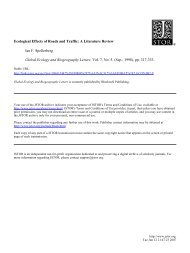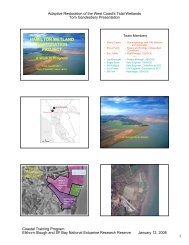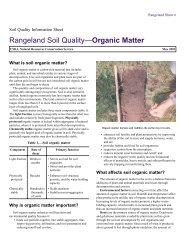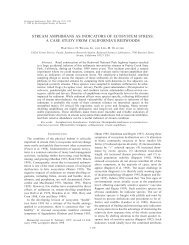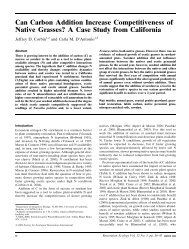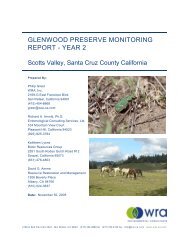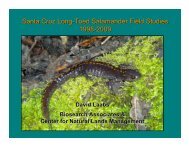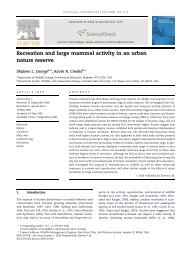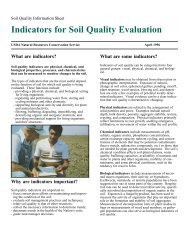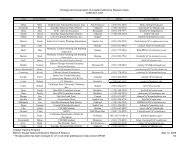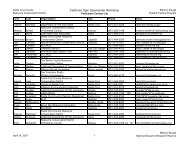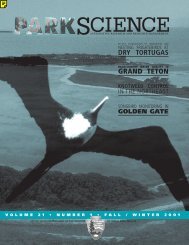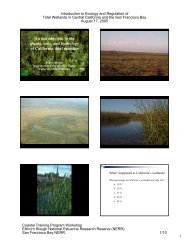WETLAND <strong>BIRD</strong>S OF GHANAAvicennia africana interspersed with Cyperusarticulatus, Paspalum vaginatum and Azadirachtaindica (Attuquayefio and Gbogbo 2001). LaiwiLagoon (5º42’N, 0º04’E) is 7.5 km 2 in extent andhas Avicennia africana, Sesuvium portulacastrumand Philoxerus vermicularis as the maincomponents of its vegetation. Mukwe and Laiwilagoons are two of the many small non-Ramsarsites on the Ghana coast that are publiclyowned. The only management at Mukwe andLaiwi lagoons is a customary regulation thatforbids people from fishing on Fridays andTuesdays, respectively.SURVEY METHODSThe total area of each wetland was divided intosectors with the aid of natural and artificialfeatures that serve as land marks. By walkingalong designated routes through each sector, thenumber of individuals of each waterbird specieswas recorded monthly between September 2008to April 2009 and September 2009 to April 2010,which are non-breeding seasons. Counting wasdone in the third quarter of each month duringlow tide using the naked eye, binoculars (8 x42mm) and a telescopes (zoom 20-60) mountedon tripods. To minimize the incidence of doublecounting, birds seen flying were not counted(Bibby et al. 2000). Data from the various sectorsfor each species were compiled after everycounting session to obtain the total number ofindividuals on the various wetlands.DATA ANALYSISData were separated between Ramsar and non-Ramsar sites. The number of each waterbirdspecies on the Ramsar and non-Ramsar siteswas divided by the species total number andmultiplied by 100 to obtain an estimate ofRelative Abundance (RA).Thus,RA R = N_________R x 100, andN R +N NRRA RN = ___________ N NR x 100,N R +N NRwhere RA R = relative abundance of species i onthe Ramsar sites, N R = total number of species ion the Ramsar sites, N NR = total number ofspecies i on the non-Ramsar sites and RA NR =relative abundance of species i on the non-Ramsar sites. On the basis that the Ghana coasthas ~100 wetlands of which five are managed asRamsar sites, the number of waterbirds of eachspecies that the five Ramsar sites might supportwas extrapolated from the number counted onthe two Ramsar sites, given thatE R = _____ 5 N R,2where E R = the extrapolated number ofwaterbirds of species i that the 5 Ramsar sites incoastal Ghana might support.Similarly, the number of waterbirds of eachspecies that the 95 non-Ramsar sites mightsupport was extrapolated from the number ofwaterbirds on the two non-Ramsar sitessurveyed, such thatE NR= 95 N NR ,______2where E NR = the extrapolated number of waterbirdsof species i of the 95 non-Ramsar sites. Thenumber of non-Ramsar sites needed to supportthe equivalence of E R (W NR) was calculated foreach species of waterbird given thatW NR = E R / (N NR ÷ 2).The percentage bird representation on theRamsar sites (E BR), signifying the number ofbirds on the Ramsar sites as a fraction of thetotal number of birds on Ghana’s coastalwetlands, was calculated for each species. Thus,E BR = E R x 100._________E R + E NROn the basis of W NR and E BR, the waterbirdswere put into 6 categories as follows:Category 1. Species found solely on the Ramsarsites whose E BR was 100% and W NR wasundetermined.Category 2. Species for which the total number ofnon-Ramsar wetlands needed to support thebird equivalence E R is greater than the numbersthat exist on the coast. Thus calculated W NR is>95.Category 3. Species for which the total number ofnon-Ramsar wetlands needed to support thebird equivalence E R was lying between 51% and100% of the total number of non-Ramsarwetlands on the coast. Thus W NR lies between 48and 95.Category 4. Species for which the total number ofnon-Ramsar wetlands needed to support thebird equivalence E R lies between 21% and 50% of[58]
FRANCIS GBOGBO AND DANIEL K. ATTUQUAYEFIOthe total number of non-Ramsar wetlands on thecoast. Thus W NR lies between 20 and 47.Category 5. Species for which the total number ofnon-Ramsar small-scale wetlands needed tosupport the bird equivalence E R lies between 1%and 20% of the total number of non-Ramsarwetlands existing on the coast. Thus W NR liesbetween 1 and 19.Category 6. Species found solely on the non-Ramsar sites whose EBR were 0% and theirWNR is undetermined.RESULTSA total of 48 species of waterbirds wererecorded over the 16-mo period of study (seeTable 1). Excepting Wood Sandpiper, BlackHeron, White-fronted Plover, Common Moorhen,Senegal Thick-knee and Greater PaintedSnipe, which had an RA RN >50%, all otherspecies had R AR >50% indicating general speciespreference for the Ramsar sites. However, asmany as 36 species of waterbirds, representing75% of the total number of species, had an E NRgreater than their E R (Table 2). Subsequentlythese 36 species had an E BR 50%, once again, highlighted the importanceof Sakumo and Densu Delta Ramsar sitesin the support of waterbirds. This, therefore,confirmed that Ramsar sites play invaluableroles in the support of waterbirds on the coast ofGhana. Most non-Ramsar sites on the Ghanacoast are small relative to the Ramsar sites. Theobservation that only 12.5% of species have theirRA NR greater than their R AR, therefore, supportsthe report of Peterjohn and Sauer (1997) thatwetlands that are small play a minimal role inthe support of waterbird species in this area.On the other hand, given that coastal Ghanahas a large number of small-sized butunmanaged wetlands that are non-Ramsar sites,comparison of the values of E R and E NR indicatesthat the dependency of waterbird species on thenon-Ramsar sites is ecologically important. TheE NR values for 39 species were greater that theirE R, rendering ~81% of the species to score E BR[59]
- Page 1 and 2:
BIRD POPULATIONSA journal of global
- Page 3 and 4:
BIRD POPULATIONSA journal of global
- Page 6 and 7:
ROBERT L. WILKERSON AND RODNEY B. S
- Page 8 and 9:
ROBERT L. WILKERSON AND RODNEY B. S
- Page 10 and 11: ROBERT L. WILKERSON AND RODNEY B. S
- Page 12 and 13: ROBERT L. WILKERSON AND RODNEY B. S
- Page 14 and 15: ROBERT L. WILKERSON AND RODNEY B. S
- Page 16 and 17: ROBERT L. WILKERSON AND RODNEY B. S
- Page 18 and 19: ROBERT L. WILKERSON AND RODNEY B. S
- Page 20 and 21: ROBERT L. WILKERSON AND RODNEY B. S
- Page 22 and 23: ROBERT L. WILKERSON AND RODNEY B. S
- Page 24 and 25: ROBERT L. WILKERSON AND RODNEY B. S
- Page 26 and 27: ROBERT L. WILKERSON AND RODNEY B. S
- Page 28 and 29: ROBERT L. WILKERSON AND RODNEY B. S
- Page 30 and 31: ROBERT L. WILKERSON AND RODNEY B. S
- Page 32 and 33: ROBERT L. WILKERSON AND RODNEY B. S
- Page 34 and 35: ROBERT L. WILKERSON AND RODNEY B. S
- Page 36 and 37: ROBERT L. WILKERSON AND RODNEY B. S
- Page 38 and 39: ROBERT L. WILKERSON AND RODNEY B. S
- Page 40 and 41: NIRANJAN DAS AND SUJATA DEORIincluy
- Page 42 and 43: NIRANJAN DAS AND SUJATA DEORIprovid
- Page 44 and 45: NIRANJAN DAS AND SUJATA DEORIpopula
- Page 46 and 47: NIRANJAN DAS AND SUJATA DEORITABLE
- Page 48 and 49: NIRANJAN DAS AND SUJATA DEORITABLE
- Page 50 and 51: NIRANJAN DAS AND SUJATA DEORITABLE
- Page 52 and 53: NIRANJAN DAS AND SUJATA DEORITABLE
- Page 54 and 55: NIRANJAN DAS AND SUJATA DEORITABLE
- Page 56 and 57: NIRANJAN DAS AND SUJATA DEORITABLE
- Page 58 and 59: Bird Populations 10:56-64© The Ins
- Page 62 and 63: WETLAND BIRDS OF GHANATABLE 1. Data
- Page 64 and 65: WETLAND BIRDS OF GHANATABLE 2: Esti
- Page 66 and 67: WETLAND BIRDS OF GHANAATTUQUAYEFIO,
- Page 68 and 69: JANNIK HANSEN, LARS HOLST HANSEN, N
- Page 70 and 71: JANNIK HANSEN, LARS HOLST HANSEN, N
- Page 72 and 73: JANNIK HANSEN, LARS HOLST HANSEN, N
- Page 74 and 75: JANNIK HANSEN, LARS HOLST HANSEN, N
- Page 76 and 77: JANNIK HANSEN, LARS HOLST HANSEN, N
- Page 78 and 79: JANNIK HANSEN, LARS HOLST HANSEN, N
- Page 80 and 81: JANNIK HANSEN, LARS HOLST HANSEN, N
- Page 82 and 83: JANNIK HANSEN, LARS HOLST HANSEN, N
- Page 84 and 85: JANNIK HANSEN, LARS HOLST HANSEN, N
- Page 86 and 87: JANNIK HANSEN, LARS HOLST HANSEN, N
- Page 88 and 89: JANNIK HANSEN, LARS HOLST HANSEN, N
- Page 90 and 91: BIRD POPULATIONSA journal of global
- Page 92 and 93: Bird Populations 10:90-109© The In
- Page 94 and 95: DAVID J. ZIOLKOWSKI JR., KEITH L. P
- Page 96 and 97: DAVID J. ZIOLKOWSKI JR., KEITH L. P
- Page 98 and 99: DAVID J. ZIOLKOWSKI JR., KEITH L. P
- Page 100 and 101: DAVID J. ZIOLKOWSKI JR., KEITH L. P
- Page 102 and 103: DAVID J. ZIOLKOWSKI JR., KEITH L. P
- Page 104 and 105: DAVID J. ZIOLKOWSKI JR., KEITH L. P
- Page 106 and 107: DAVID J. ZIOLKOWSKI JR., KEITH L. P
- Page 108 and 109: DAVID J. ZIOLKOWSKI JR., KEITH L. P
- Page 110 and 111:
DAVID J. ZIOLKOWSKI JR., KEITH L. P
- Page 112 and 113:
Bird Populations 10:110-113© The I
- Page 114 and 115:
THE 2007 AND 2008 NORTH AMERICAN BR
- Page 116 and 117:
Bird Populations 10:114-124© The I
- Page 118 and 119:
BREEDING BIRD CENSUS: 2007on the pl
- Page 120 and 121:
BREEDING BIRD CENSUS: 2007May, with
- Page 122 and 123:
BREEDING BIRD CENSUS: 2007Remarks:
- Page 124 and 125:
BREEDING BIRD CENSUS: 200717. PITCH
- Page 126 and 127:
BREEDING BIRD CENSUS: 2007+; Wester
- Page 128 and 129:
BREEDING BIRD CENSUS: 2008gray Gnat
- Page 130 and 131:
BREEDING BIRD CENSUS: 2008Warbler,
- Page 132 and 133:
BREEDING BIRD CENSUS: 2008Source: W
- Page 134 and 135:
BREEDING BIRD CENSUS: 2008Spotted T
- Page 136 and 137:
BREEDING BIRD CENSUS: 2008precipita
- Page 138 and 139:
Bird Populations 10© The Institute
- Page 140 and 141:
IS AVIAN BREEDING SUCCESS WEATHERIN
- Page 142 and 143:
IS AVIAN BREEDING SUCCESS WEATHERIN
- Page 144 and 145:
DAVE LEECH AND CARL BARIMOREFlycatc
- Page 146 and 147:
Bird Populations 10:143-145Reprinte
- Page 148 and 149:
WOODPIGEON JOINS THE GARDEN PREMIER
- Page 150 and 151:
CHANGING THE GUARD AT UK BIRDTABLES
- Page 152 and 153:
Bird Populations is an entirely ele
- Page 154:
BIRD POPULATIONSA journal of global



